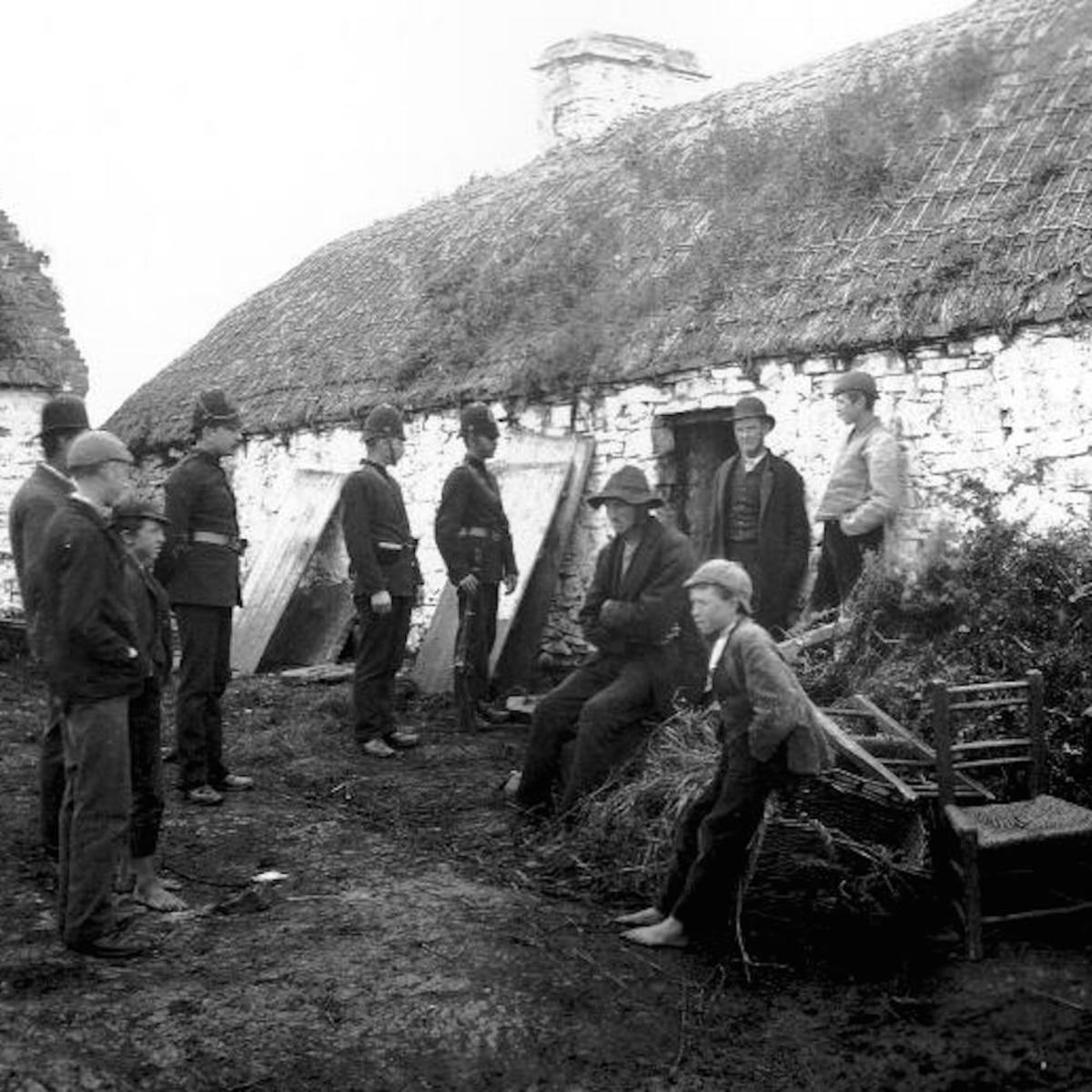Irish Diaspora: Ireland’s Citizens beyond Seas

Updated On: November 07, 2023 by ConnollyCove
The Irish are everywhere. It may come as a surprise to some that Irish people are spread in different places around the world, and they are one of the most widely scattered nationalities in the world. This is known as the Irish diaspora.
There are over 70 million people living outside Ireland claim to have Irish blood, more than half of them in the United State. To put it simply, this all means that one in six of the people born in Ireland live abroad. This figure also exceeds the population of the island of Ireland in the north and south (6.6 million), and it is much bigger than the population of Ireland at its peak in 1845 before the Great Famine took place (8.5 million).
So why did all of this happen? Why is Irish Diaspora is a real thing? We’re here to dig deep into this and present you with some history and facts into the whole situation!
What Is a “Diaspora”?
The term “Diaspora” is derived from the verb diaspeiro – a compound of dia(over or through) and speiro (to scatter or sow). It first appeared around 250 BCE in the Greek translation of the opening books of the Hebrew Bible, known as the Septuagint, produced by Jewish scholars based in Alexandria.
It is defined as any group migration or flight from a country or region; or any group that has been dispersed outside its traditional homeland. Therefore, the Irish Diaspora refers to Irish emigrants and their descendants who live in countries outside of Ireland.
“Irish diaspora” first appeared in a 1954 book titled The Vanishing Irish, but it was not until the 1990’s that the phrase came to be more widely used to describe Irish emigrants and their descendants around the world, all thanks to former president Mary Robinson. In her 1995 address to the Joint Houses of the Oireachtas, she mentioned “Cherishing the Irish Diaspora”, by reaching out to the millions of people worldwide who can claim Irish descent. She went on to describe what she thinks about this Irish diaspora: “The men and women of our diaspora represent not simply a series of departures and losses. They remain, even while absent, a precious reflection of our own growth and change, a precious reminder of the many strands of identity which compose our story”.
In its essence, diaspora is neither a process or a thing to be defined in concrete terms, but rather a conceptual framework through which people try to make sense of the experience of emigration.
History of Irish Diaspora
Irish diaspora started at the onset of the American Revolution. For the most part of the 18th century, the mostly Irish Presbyterian emigrants settled in the mainland American Colonies. Followed by the German, Scots, and English, they constituted the biggest group of settlers to North America.
18th-Century Irish Emigration and the Irish Famine
The Irish Famine (Bliain an Ãir) took place in 1740 to 1741 and was caused by a natural disaster called The Great Frost that struck Europe along with Ireland with harsh cold and excessive rain. This resulted in devastating harvests, hunger, disease, death, and civil unrest.
During and after this famine, many Irish families either moved around within the country or left Ireland completely. Of course, the poorest of these families couldn’t afford to migrate and were excluded from this social and economic opportunity and remained in Ireland where many perished. Ireland was considered mostly rural during this era with complex issues of social inequality, religious discrimination and many people below the poverty line.
It is safe to say that Ireland was completely unprepared for this famine and its consequences. All these tough food shortages and the increased cost of the available food and welfare led to the masses seeking better survival opportunities elsewhere. The exact numbers of emigrants at that time are unavailable, but it is believed that the ratios are likely to resemble those who emigrated during the next famine known as The Great Famine of 1845 to 1852 ─ more on that in a sec.
When those emigrants moved to the US, the majority of them settled in Pennsylvania, which offered land on attractive terms and exceptional religious toleration. From there, they moved down all the way to Georgia. Several of their descendants became US presidents, starting with Andrew Jackson, whose parents arrived in the Carolinas from Ulster in 1765, two years before he was born, and who was the first US president not born into the elite of the American colonies.
19th-Century and The Great Irish Famine
The Great Irish Famine (an Gorta Mar) was known globally as the Irish Potato Famine or The Great Hunger. The event was a result of the potato blight disease that devastated the crops that up to a third of the population depended upon as a staple food. This catastrophe led to the death of a million people after dying of starvation and up to another three million left the country to try and make a new life abroad. Even the death numbers are unreliable as the dead were buried in mass graves without a trace. In some districts, entire communities disappeared as residents died, were evicted, or were fortunate enough to have the means to emigrate.
Most of the ships that the emigrants used to travel were in extremely poor conditions and were dubbed “coffin ships.” The Jeanie Johnston is one of the ships and a perfect example of the famine ships that were used during the 1800s.

Before the start of the Great Famine in 1845, the numbers and the pace of Irish emigration was still increasing significantly. Almost 1 million Irish people were moving to North America to the town and cities of Canada from 1815 to 1845. Moreover, other Irish people were moving to England to look for sustainable lives in the centre of Britain. Ulster Presbyterians continued to dominate the transatlantic flow until the 1830s, at which point Catholic immigration from Ireland overtook Protestant. In the 1840s, the Irish accounted for 45 per cent of the total number of immigrants to the US. In the 1850s, the Irish and the Germans each made up about 35%.
Likewise, the Irish emigration to Canada was considerable and heavy. During 1815 and the years that followed many tradesmen from Ireland travelled to Saint John, New Brunswick to start the backbone for the workforce of the city and at halfway through the century, there had been over 30,000 Irish people leaving Ireland to make Saint John their new home.
Those that were lucky enough escape Ireland and to survive the long travel to Canada the hardship for them didn’t stop there. With very little money and practically no food, most Irish moved onto the United States in search for better opportunities. For the Irish that did settle in Canada, they worked for low wages. They helped expand the Canadian economy by building bridges and other buildings between 1850 and 1860.
Irish Diaspora at Its Most Noticeable
By 1850, over a quarter of the New York City population was estimated to be Irish. A New York Times article recounted the seemingly unstoppable flow of Irish immigration on April 2, 1852:
“On Sunday last three thousand emigrants arrived at this port. On Monday there were over two thousand. On Tuesday over five thousand arrived. On Wednesday the number was over two thousand. Thus in four days twelve thousand persons were landed for the first time upon American shores. A population greater than that of some of the largest and most flourishing villages of this State was thus added to the City of New York within ninety-six hours.”
With over 100,000 Irish people travelling from Ireland to Boston to search for work, they were mostly met by hostility and racism. The Irish were determined to stay in Boston and quickly proved to locals they were dedicated, hard workers.
20th-Century Irish Emigration and Modern Distresses
The flow of Irish migration continued through till the 20th century and saw a steady increase in the number of immigrants although with a smaller pace than before. The unsustainable agricultural farming, government protectionist and isolating policies, exclusion from European economic booms, and the sociopolitical uncertainty in Ireland made the opportunities abroad seem more tempting than the ones at home.
In the US and western Europe, this was a period of massive population growth, industrialisation and urbanisation. Ireland’s population, by contrast, was cut in half, its industrial base contracted, and the number of people living in cities declined. Migration from the countryside to cities was common everywhere, but because Ireland lacked cities or industries to absorb its displaced rural population, those who left the countryside had little choice but to move abroad.
Pressure for land remained the main source of emigration. Before the Famine, the Irish had married young, but now they delayed marriage until they had access to land – often a very long wait. Everyone who has grown up in Ireland since the Famine has known that, come early adulthood, they would have to grapple with the decision of whether to stay in the country or leave. For many young women, in particular, leaving Ireland came as a welcome escape from the stultifying constraints of rural life. Uniquely among European emigrants in the late-19th century, young single women emigrated from Ireland in the same numbers as men.
In the post-Famine era (1856-1921) more than 3 million Irish emigrants went to the US, 200,000 to Canada, 300,000 to Australia and New Zealand, and as many as 1 million to Britain. When the 20th century came its way, it was recorded that two out of every five Irish-born people were living overseas.
Following World War II, during the 1940s and 1950s, the level of emigrations almost paralleled those of a century earlier, however, a huge number Irish emigrants went to Britain as well. In the 1960s and ‘70s, emigration from the Republic of Ireland declined significantly and, for the first time since the Famine, Ireland’s population increased.
Come the 1980s, a “lost generation” is created as the young and well-educated fled the country to seek better employment and lifestyles abroad wherever they could go. In the 1990s, Ireland had a boom in the economy and was known as the “Celtic Tiger” economy and it attracted for the first time, large numbers of foreign-born immigrants as well as a return of previous emigrants.
For a second, it was seemingly convenient that Ireland might be on its course to reverse the tradition and become a bigger nation, a tantalising prospect that, however, vanished with the 2008 financial crisis.
21st-Century Irish Emigration and Economic Stagnation
Emigration is once again the Irish response to national strifes in this century. In 2013, a University College Cork’s Émigré Project publication revealed that 21st-century Irish migrants have a better education than their native counterparts; that the rural areas of Ireland have been affected more by emigration than urban towns and cities; and that one in four households has said goodbye a family member to another country since 2006.
Additionally, an International Monetary Fund/European Union bailout of Irish banks, high unemployment, unprecedented redundancies and business closures saw the tripling of Irish people leaving the country between 2008 and 2012. While it’s perhaps good and relieving to the economy for the number of people to grow less in a rising country, the social scars of further dislocation, dispersal and displacement will again take generations to mend.
The first Irish Diaspora Policy was launched in March 2015. Politician Enda Kenny made a comment at the launch that, “Emigration has a devastating impact on our economy as we lose the input of talent and energy. We need these people at home. And we will welcome them.”
The Impact of Irish Diaspora

According to the UN, over 240 million people now live outside the country they were born in, whether they are migrants or refugees. If they formulated their own country, it would be the fifth-largest country in the world in population. What can be deduced from this is that new geography has been created through migration and we can see a distinction between the state and the nation – the former referring to lines on a map and the latter being a global notion.
While it’s true that diaspora is the product of migration (meaning that they are interlinked), both terms are perceived differently. Migration can be viewed as emotionally charged and toxic for the political climate of a country. On the other hand, diaspora and is attracting attention from governments who are realizing that who were once “lost actors” can now be seen as “national assets”. They are called “Diaspora Capital” for how they are overseas resources “available to a country, city, region, organisation or place”.
As anyone can imagine, the famine and migration to America and Canada and other countries played a huge part in the history of Ireland. This history is taught nowadays in many schools to help educate the younger generation in what hardships their past country people had gone through.
Ireland has a Ministry of the Diaspora, a national diaspora policy, an Irish Abroad Unit of the Department of Foreign Affairs – which funds Irish community organisations around the world with over €12 million annually – and a Global Irish Network of 350 CEOs around the world and many hundreds of Irish diaspora organisations in business, sport, culture, education and philanthropy.
Moreover, The Ireland Funds working in the area of diaspora philanthropy has raised over $550 million for thousands of organisations of peace, culture, charity and education throughout Ireland.
For what it was worth, the long history of Irish emigration featured winners as well as losers. For the most part, those who managed to stay in Ireland did rather well. Emigration might have inhibited economic development in some ways – by reducing the demand for goods and services, for example, and by lessening the need for rural innovation. But by significantly lowering the size of the population and competition over resources, and by attracting remittances from abroad, emigration raised the standard of living at home. Above all, emigration acted as a social safety valve by reducing poverty, unemployment and class conflict. A big untold story in the history of Irish emigration is the benefits it produced for those who stayed behind.
Irish Diaspora in Statistics and Numbers
All in all, Americans of Irish descent make up almost 10% of the US population (the number of people claiming Irish ancestry is nearly 35 million) down from 15% in 1990. This is second only to Americans of German descent at 14%, down from 23% in 1990).
If we turn away from the Northeast, there are several Irish-American groups in the West and the Deep South, albeit less in numbers. Missouri, Tennessee and West Virginia have populations that include many “Scotch-Irish” who have been in the United States for many generations and identify as Protestant.
Census data indicate that Irish-Americans are now better educated, more successful and more likely to work in white-collar jobs than are U.S. residents as a whole. They are also more likely to be homeowners rather than renters, which helps explain why the Irish population is noticeably higher in suburban counties than in cities like New York, Philadelphia and even Boston.
However, Irish presence in the United States is in a long decline. American-Irish people are, on average, older than other US citizens.
Nowadays, around 70 million people claim Irish heritage or ancestry worldwide according to the Irish government, which is quite a number for an island of only 6 million people. The vastness of the global Irish diaspora means St. Patrick’s Day is practically an international holiday, with people popping open a Guinness and celebrating all the way from Vancouver in Canada to Auckland in Australia.
The UK has about 500,000 Irish migrants within its borders. While relations between the English and Irish have always been tense in the past, it is clear that the Irish have influenced their neighbour and vice versa. Former British Prime Minister Tony Blair and writer Charlotte Brontë are among many famous Britons who can claim Irish ancestry.
In Australia, home to the third-largest population of Irish migrants, about 2 million people, or 10% of the population, said they were of Irish descent in the 2011 census. In Canada, which also has many Irish emigrants, about 13% of the population claims Irish roots.
Irish Diaspora between the Old and the New
The rate of the Irish leaving dropped dramatically when famine cleared and although numbers dropped the Irish didn’t stop emigrating. To this day hundreds of Irish people emigrate yearly to places such as Britain, the United States, Canada, Germany, Japan, and Australia. A reason why so many people have such a great connection with Ireland.






